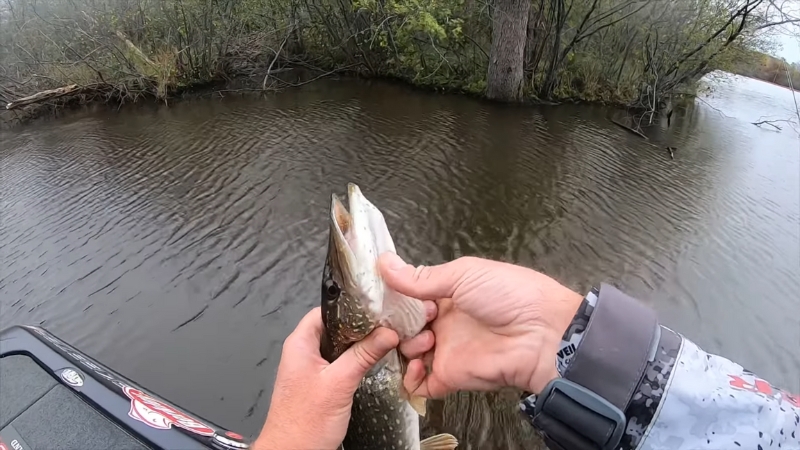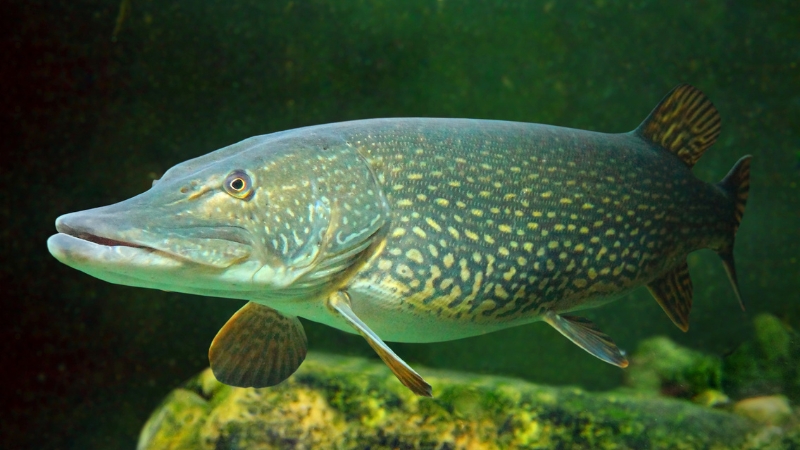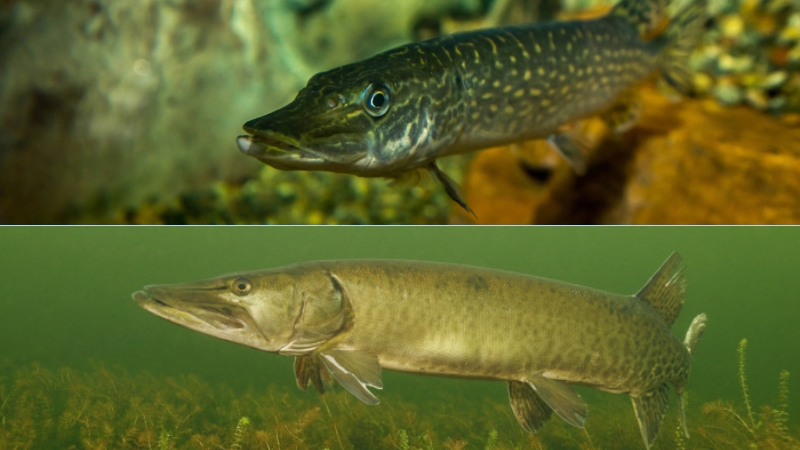Before we get into spotting differences, it helps to know what kind of fish you’re dealing with.
Northern Pike (Esox lucius) are found throughout most of the northern U.S. and across Canada. They’re common in weedy bays, shallow lakes, and slow-moving rivers. You’ll catch them in Minnesota, Michigan, Wisconsin, the Dakotas, and just about every Canadian province.
Muskellunge, or Muskie (Esox masquinongy), share a lot of that range, but they’re not nearly as widespread. They’re more finicky, less abundant, and generally harder to catch.
Wisconsin, Minnesota, and parts of Canada are known for them. There are also solid populations in states like New York and Pennsylvania.
In short, Pike is the rowdy cousins who crash every party. Muskies show up late—if at all—but they make a scene when they do.
Quick Comparison Table
Here’s a cheat sheet for when you’re on the water and need fast answers:
| Feature | Northern Pike | Muskie |
| Markings | Light spots on a dark body | Dark bars/spots on a light body |
| Pores under the jaw | 5 or fewer per side | 6 or more per side |
| Tail fin | More rounded | More pointed |
| Body color | Green with yellow/white spots | Silver, gold, or greenish-brown with bars or faint spots |
| Size (typical) | 20–35 inches | 30–50+ inches |
| Behavior | More aggressive, easier to catch | More elusive, cautious |
| Habitat | Shallow weedy bays | Open water, structure edges |
Let’s unpack some of these a bit more.
Spot Check: The Fastest Way to Tell the Difference
View this post on Instagram
The Pattern on the Body
This is probably the easiest giveaway, especially when the fish is fresh out of the water and you’ve got a good look.
- Pike: Think light on dark. They’ve got creamy or yellowish spots on a darker green background.
- Muskie: Think dark on light. Depending on the strain, they have vertical bars, spots, or even a near-clear pattern, but always darker than the body.
Pores Under the Jaw

If you’re still not sure, flip the fish gently and look under its jaw, right along the lower edge.
It’s not the easiest to count if the fish is squirming, but if you’re handling it anyway for a quick release or measurement, it’s a definitive check.
The Tail Tells a Tale
Take a look at the caudal fin (the tail). Shape makes a difference.
- Pike tails are more rounded, a little softer looking.
- Muskie tails are sharper and more pointed, giving them that extra edge in bursts of speed.
You can see the difference best when the tail is relaxed and fanned out. It’s a subtle clue, but paired with markings, it’s pretty reliable.
Size Isn’t Always the Dealbreaker
@southern865_yooper906 #stitch with @Fishbtm1989 #greenscreensticker #pike #muskie ♬ original sound – Southern865_yooper906
There’s a myth that you can always tell a Muskie from a Pike just by size. And while Muskie can get huge (50 inches or more isn’t unheard of), Pike can also hit the upper 40s if they’ve been eating well and living long.
Plenty of young Muskie get mistaken for Pike because they’re in the 25–35 inch range.
And vice versa—someone hauls in a 38-inch Northern and suddenly everyone’s yelling “Muskie!” across the lake.
So yeah, size helps, but it’s not a silver bullet.
Color and Strain Confusion
Here’s where it gets a little tricky. Muskie have different “strains” that affect their markings:
- Barred Muskie: Vertical dark bars on a light background.
- Spotted Muskie: Dark spots instead of bars.
- Clear Muskie: Almost no markings at all—just a silvery or light green body.
That clear strain can look a lot like a large Northern, especially when stress or water clarity dulls their pattern. The best way to sort it out is still to check the jaw pores and tail shape.
Don’t rely on color alone.
Behavior Can Tip You Off

Fish don’t carry ID cards, but they do have personalities.
- Pike are generally more aggressive. They’ll hit lures repeatedly, even when they’re not hungry. They don’t always spook easily, and you’ll catch them more often during midday or poor conditions.
- Muskie are notorious for following a lure all the way to the boat, staring at it like they’re inspecting fine art. They’ll test your patience. They’re also sensitive to weather shifts and tend to feed in short windows.
If you’re getting lots of chasers and nothing bites, that’s a muskie mood. If you’re getting smacked repeatedly in the shallows, probably pike.
Where You Caught It Matters
Location plays a huge role. Not all lakes have both species, and not all habitats suit both fish equally.
- Weedy bays, backwater sloughs, shallow river arms — Pike love these. They’ll sit right in the salad waiting to ambush.
- Edge of drop-offs, deep weed edges, open points — More likely Muskie territory. They like room to roam and structure to stage.
So if you’re flipping spinnerbaits in two feet of water and hook a 30-incher with spots, it’s likely a Northern. If you’re trolling a deep crank along a mid-lake hump and get slammed? Could be a muskie.
Top Waters for Pike and Muskie
Where you’re fishing plays a huge role in what’s on the end of your line. Some lakes are classic muskie water, others are packed with pike, and a few give you a shot at both.
- Lake of the Woods (MN/Canada) – Huge, weedy, and full of life. You’ll find muskies in deeper structure, but this lake is a staple for aggressive northern pike action in the bays.
- Mille Lacs Lake (MN) – A trophy muskie destination, but don’t ignore the shallow flats—especially in spring—where pike hunt along weed edges.
- Crane Lake (MN) – A quiet gem near the Canadian border. Known for clear water and strong northern populations, it’s one of the better spots for Minnesota northern pike fishing, especially around rock piles and weed breaks.
- Eagle Lake (Ontario) – Muskie country through and through, though solid pike bite in the coves and shallows early in the season.
- St. Lawrence River (NY) – Deep, structured, and classic muskie territory. You’ll get follows here, but pike are less common.
When in doubt, let the lake help you decide. Pike prefer shallow, weedy chaos. Muskies favor deeper edges and open water structure. Fish accordingly.
What About Hybrids?
View this post on Instagram
Ah, yes, the Tiger Muskie — a hybrid between a Northern Pike and a Muskie. These are stocked in a bunch of states and show traits from both parents.
- They usually have tiger-like vertical stripes, hence the name.
- They tend to grow fast but don’t get quite as long as pure-strain Muskie.
- Behavior-wise, they’re more aggressive like Pike, but elusive like Muskie. Great fight, too.
So if you catch something that really looks like a mix of both—striped body, pointy tail, attitude to match—it could be a tiger. Some states (like Utah, Colorado, and parts of the Midwest) even stock them intentionally.
Bonus Tips
Here are a few quick tricks anglers use when they don’t have time for biology class on the boat:
- Snap a clear photo: If you’re releasing quickly and aren’t sure what you caught, grab a photo and check it later.
- Don’t trust local lore alone: Just because someone says, “there’s no Muskie in this lake,” doesn’t make it true. Stocking efforts change over time.
- Know the regs: Size and catch limits often vary by species. Make sure you know whether it’s legal to keep what you caught, or even if you’re allowed to target it.
The Bottom Line: You Don’t Need to Guess
Telling a Northern Pike from a Muskie isn’t about having a degree in fisheries biology. It’s about pattern recognition, knowing where you’re fishing, and picking up a few small details—jaw pores, markings, tail shape.
Once you’ve seen a few of each species, it gets easier to call them confidently. And sure, they might look like underwater twins at first, but once you’ve had one blow up a topwater lure or shadow your bucktail for 20 feet before vanishing into the dark… you’ll never forget which is which.
Fish are often more active in the early morning or evening, making those moments even more thrilling.
One fights dirty. One plays hard to get. Both are worth chasing.

